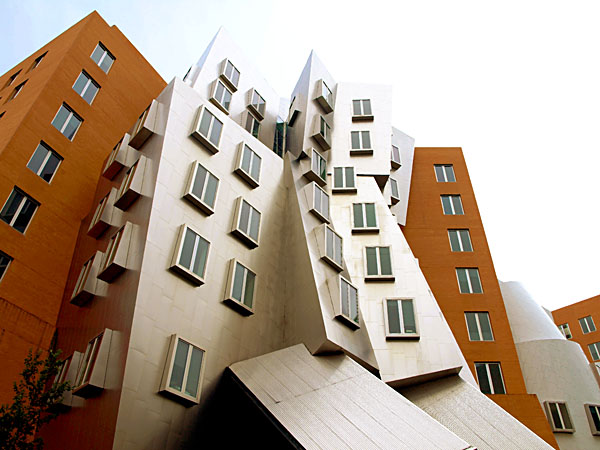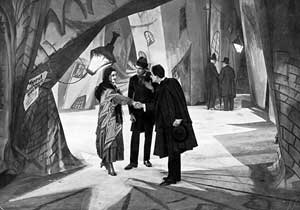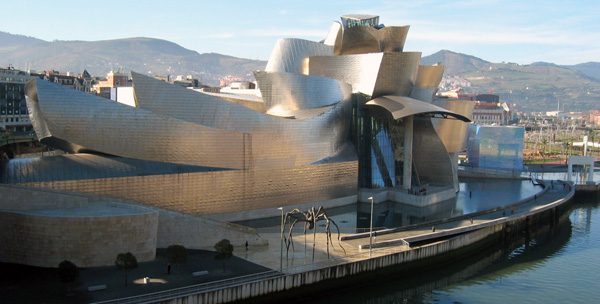Radical Buildings
Today, radical buildings. The University of Houston's College of Engineering presents this series about the machines that make our civilization run, and the people whose ingenuity created them.
Last year, I had a chance to see MIT's new Stata Center. That's architect Frank Gehry's building that looks like something from an old German Expressionist movie -- no parallel lines, planes tilted every which way -- its sections seemed poised to fall over.

 It'd been fifty years since I'd seen the 1919 movie classic, The Cabinet of Dr. Caligari so, to refresh my memory, I went to Roger Ebert's fine review of the movie. He says:
It'd been fifty years since I'd seen the 1919 movie classic, The Cabinet of Dr. Caligari so, to refresh my memory, I went to Roger Ebert's fine review of the movie. He says:
The first thing everyone notices and best remembers about [it is its] bizarre look. The actors inhabit a jagged landscape of sharp angles and tilted walls and windows, staircases climbing crazy diagonals, trees with spiky leaves, grass that looks like knives. These radical distortions immediately set the film apart from all earlier ones, which were based on the camera's innate tendency to record reality.
Such distortion sets people's teeth on edge. I wish I could've watched the public
reaction to the Stata Center without all its additional design problems. Leaks, cracks, mold, exit blockages, and a resulting lawsuit all fueled the fire of discontent with its appearance. I wonder how that fire would've burned without the extra fuel.
Experience suggests that it still would've had a hard time. Radical architecture has a long history of turmoil -- even many of the masterpieces. At first, French intellectuals roundly lambasted the Eiffel Tower. Christopher Wren had to fight a clandestine war with his seventeenth-century Planning Commission to build the domed Cathedral of St. Paul in London. Maya Lin's Viet Nam Memorial in Washington, DC endured a firestorm that subsided only when the public started coming to touch the names and weep for the fallen.
Of course, while any radical masterpiece stirs trouble, trouble is no guarantee of a masterpiece. The jury is still out on the Stata Center (despite my own guilty fascination with it.)
Since the Center is such a clear homage to German Expressionism, we might ask how Expressionism itself fared. The NAZIs came to power thirteen years after Caligari movie and promptly pronounced the whole movement degenerate. They specifically included Caligari. Most of the Expressionist school is highly regarded today, but Hitler's condemnation may've actually helped a merely so-so movie. New York Times critic Pauline Kael warned us,
This film [is] entrenched in the "masterpiece" classification ... your initial reaction may be disappointment. You may be delighted that the [scenery expresses] something, because most of the actors don't.
My inventor friends often lament that they're misunderstood -- that the public doesn't "get it". Well, of course they don't; we violate the norms when we invent. An invention with real value, will find its way into people's hearts; but no one can predict that. So time alone will tell about the Stata Center. But just think how much poorer we'd be if people weren't constantly putting their necks on the line to put their dangerous new ideas before us.
I'm John Lienhard at the University of Houston, where we're interested in the way inventive minds work.
See the Wikipedia articles on the Stata Center and The Cabinet of Dr. Caligari. See also Pauline Kael's review of that movie in her online book 5001 Nights at the Movies.
I actually saw The Cabinet of Dr. Caligari at the Berkeley, California, movie house, the Cinema Guild and Studio, which was run by Pauline Kael before she became a famous national movie critic. All photos courtesy of Wikipedia Commons, except that of the Stata Center, which I took. I appreciate the counsel of Margaret Culbertson and Jean Krchnak.
Here is one of several online viewable versions of The Cabinet of Dr. Caligari.

Another, far more famous, Frank Gehry building -- The Guggenheim museum in Bilbao, Spain
